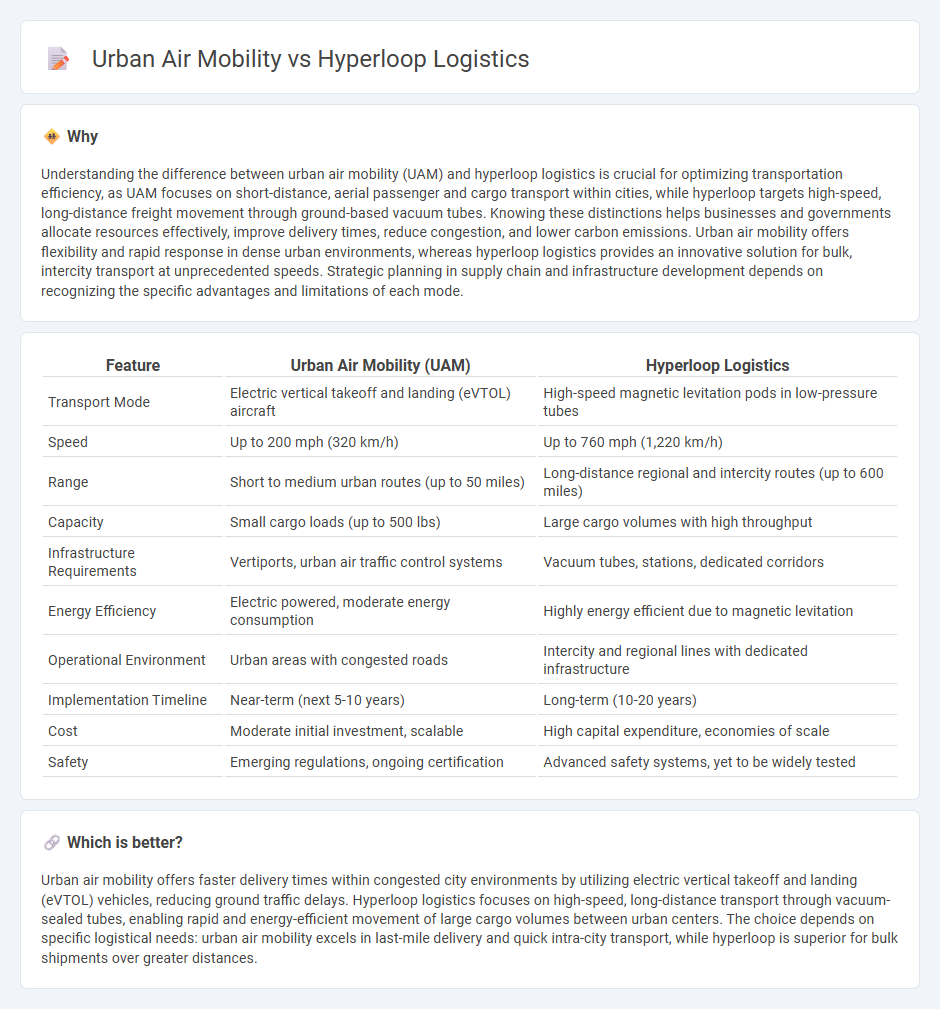
Urban air mobility enhances logistics by enabling rapid, flexible delivery through electric vertical takeoff and landing (eVTOL) aircraft, reducing ground traffic congestion in metropolitan areas. Hyperloop logistics leverages high-speed vacuum tube transport to move freight efficiently over long distances with minimal energy consumption and reduced transit times compared to traditional rail or road. Explore how these transformative technologies redefine the future of urban and intercity logistics solutions.
Why it is important
Understanding the difference between urban air mobility (UAM) and hyperloop logistics is crucial for optimizing transportation efficiency, as UAM focuses on short-distance, aerial passenger and cargo transport within cities, while hyperloop targets high-speed, long-distance freight movement through ground-based vacuum tubes. Knowing these distinctions helps businesses and governments allocate resources effectively, improve delivery times, reduce congestion, and lower carbon emissions. Urban air mobility offers flexibility and rapid response in dense urban environments, whereas hyperloop logistics provides an innovative solution for bulk, intercity transport at unprecedented speeds. Strategic planning in supply chain and infrastructure development depends on recognizing the specific advantages and limitations of each mode.
Comparison Table
| Feature | Urban Air Mobility (UAM) | Hyperloop Logistics |
|---|---|---|
| Transport Mode | Electric vertical takeoff and landing (eVTOL) aircraft | High-speed magnetic levitation pods in low-pressure tubes |
| Speed | Up to 200 mph (320 km/h) | Up to 760 mph (1,220 km/h) |
| Range | Short to medium urban routes (up to 50 miles) | Long-distance regional and intercity routes (up to 600 miles) |
| Capacity | Small cargo loads (up to 500 lbs) | Large cargo volumes with high throughput |
| Infrastructure Requirements | Vertiports, urban air traffic control systems | Vacuum tubes, stations, dedicated corridors |
| Energy Efficiency | Electric powered, moderate energy consumption | Highly energy efficient due to magnetic levitation |
| Operational Environment | Urban areas with congested roads | Intercity and regional lines with dedicated infrastructure |
| Implementation Timeline | Near-term (next 5-10 years) | Long-term (10-20 years) |
| Cost | Moderate initial investment, scalable | High capital expenditure, economies of scale |
| Safety | Emerging regulations, ongoing certification | Advanced safety systems, yet to be widely tested |
Which is better?
Urban air mobility offers faster delivery times within congested city environments by utilizing electric vertical takeoff and landing (eVTOL) vehicles, reducing ground traffic delays. Hyperloop logistics focuses on high-speed, long-distance transport through vacuum-sealed tubes, enabling rapid and energy-efficient movement of large cargo volumes between urban centers. The choice depends on specific logistical needs: urban air mobility excels in last-mile delivery and quick intra-city transport, while hyperloop is superior for bulk shipments over greater distances.
Connection
Urban air mobility and hyperloop logistics converge by revolutionizing freight transportation through faster, more efficient, and sustainable methods. Both technologies reduce urban congestion and enable real-time delivery within smart city ecosystems by integrating advanced automation, electric propulsion, and IoT connectivity. Their synergy enhances supply chain resilience, drastically cutting transit times for last-mile and long-distance logistics.
Key Terms
High-Speed Freight Corridors
High-speed freight corridors emphasize ultra-fast transport solutions such as Hyperloop logistics and Urban Air Mobility (UAM), with Hyperloop providing vacuum-sealed tube highways achieving speeds over 700 mph, ideal for long-distance, cargo-heavy routes. Urban Air Mobility focuses on efficient air transit within metropolitan areas, deploying electric vertical takeoff and landing (eVTOL) vehicles that optimize last-mile delivery by bypassing ground congestion. Explore these innovative technologies to understand their roles in shaping future high-speed freight transport infrastructure.
Vertical Takeoff and Landing (VTOL)
Hyperloop logistics offers high-speed, ground-based cargo transport using magnetic levitation and vacuum tubes, enabling rapid long-distance delivery with minimal environmental impact. Urban Air Mobility (UAM) focuses on Vertical Takeoff and Landing (VTOL) aircraft, providing flexible, short-range aerial transportation solutions for congested urban areas. Explore the future of efficient transport by learning more about how Hyperloop and VTOL technologies revolutionize logistics and urban mobility.
Last-Mile Connectivity
Hyperloop logistics offers ultra-fast, long-distance cargo transport with minimal delay, optimizing supply chain efficiency over vast regions, while urban air mobility (UAM) targets congested cityscapes by providing agile, point-to-point delivery in the last mile. UAM leverages electric vertical takeoff and landing (eVTOL) aircraft to bypass traffic, enhancing speed and flexibility for urban parcels, contrasting hyperloop's fixed infrastructure and terminal-based operations. Explore the evolving synergy and competitive edge between hyperloop logistics and urban air mobility in transforming last-mile connectivity.
Source and External Links
Hyperloop Freight Transport: The Future of High-Speed Logistics? - Hyperloop freight transport uses magnetically levitated pods traveling in near-vacuum tubes at speeds over 600 mph to provide ultra-fast, energy-efficient, and low-emission cargo delivery with reduced transit times and enhanced supply chain reliability.
Hyperloop Revolution: Transforming Freight Transportation for the ... - Hyperloop offers unprecedented freight speeds approaching 700 mph, enabling same-day delivery and supporting just-in-time logistics by bypassing common road and air freight bottlenecks with a sealed vacuum tube system.
Hyperloop applications in logistics - Interlake Mecalux - Hyperloop technology can revolutionize logistics by transporting freight quickly between hubs at speeds of around 750 mph using low-pressure tubes, providing a more economical alternative to air freight while maintaining essential truck transport for last-mile delivery.
 dowidth.com
dowidth.com